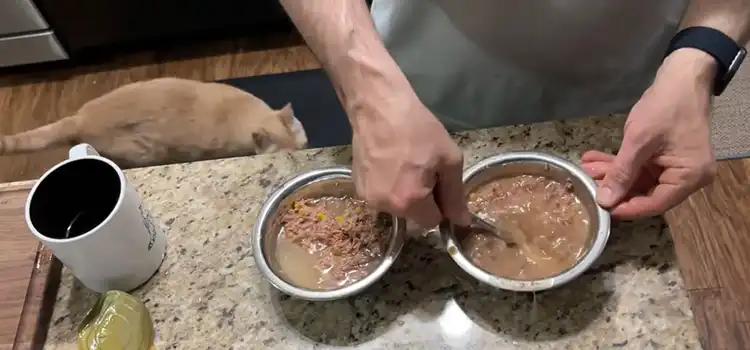Opening a can of wet cat food only to find it thick, dense, or pate-like is a common occurrence. This can tempt owners to add extra water to dilute the food and make it soupier for picky kitties. But is this practice safe and healthy for cats?
Adding small amounts of water to wet cat food is generally safe in most cases to increase moisture and flavor. However, too much-added water can reduce nutritional value, upset digestion, and encourage dental issues. Moderation and monitoring the cat’s response is key.
Let’s explore more fully the benefits and risks of adding water to wet cat food and how owners can employ this technique judiciously to support their cat’s health and happiness at mealtime.

Should You Add Water to Cat Food or Not?
Whether you should add water to wet cat food or not depends on whether your cat is going to get some benefits from it or not. So, let’s identify them first:
Potential Benefits of Added Water
There are some valid reasons why adding a small bit of water to wet food can be helpful for cats:
- Increases moisture and hydration
- Improves flavor from aroma release
- Adds broth-like appeal for picky eaters
- Makes food easier to chew for dental issues
- Provides consistency cats may prefer
The right amount of added moisture can make canned foods more palatable and digestible.
Concerns About Adding Water
While benefits exist, too much added water poses some risks owners should consider:
- Excessive water dilutes nutritional value
- Can upset digestive tract leading to vomiting or diarrhea
- Encourages lack of chewing which causes dental problems
- Alters food consistency in a way that enables gorging
- Can spoil canned food faster with extra moisture
Adding water should be done with care to avoid these issues.
Proper Way of Adding Water to Wet Cat Food
When adding water to wet food, follow these guidelines:
Step 1: Add no more than 2-3 tablespoons per 3 ounce can
Step 2: Choose plain filtered water over tap water
Step 3: Mix well to evenly distribute moisture
Step 4: Discard any uneaten diluted food within 20-30 minutes
Step 5: Adjust the amount based on your cat’s preferences
Step 6: Introduce gradually if switching your cat to diluted food
NOTE: Don’t add water if your cat has kidney disease or diarrhea
Finding the optimal moisture level takes some experimentation based on your individual cat.
Signs Your Cat Enjoys Diluted Food
Positive signs your cat welcomes some added water include:
- Eating all food promptly when water is added
- Increased excitement and interest at mealtime
- Reduction in leftover uneaten food
- Improved chewing and less gulping
- Staying at a healthy weight
As long as kitty seems to enjoy and digest the food-water blend, it’s likely a safe feeding practice.
When to Stop Adding Water?
Indications added water is inappropriate for your cat include:
- Diarrhea, vomiting, or signs of GI upset
- Increased dental tartar buildup
- Difficulty staying hydrated
- Weight loss or obesity
- Decrease in appetite or energy
If any of these issues emerge, discuss transitioning back to undiluted canned food with your vet.
What Should You Do?
Here are some considerations when deciding whether to add water to your cat’s wet food:
- Consult Your Veterinarian: Before making any significant changes to your cat’s diet, consult with your veterinarian. They can provide guidance based on your cat’s individual health and dietary needs.
- Observe Your Cat: Pay close attention to your cat’s behavior and health. If they show any signs of discomfort, gastrointestinal upset, or weight issues, consult your veterinarian promptly.
- Maintain Hygiene: Ensure proper food dish hygiene to prevent spoilage and bacterial growth.
Conclusion
While most cats enjoy canned cat food right from the can, adding a bit of water can benefit some finicky felines. This technique can encourage eating, chewing, and hydration. However, too much liquid poses health risks. Moderation and careful monitoring of your cat’s response is crucial. With the right balance suited to your pet’s needs, mealtime can be an eagerly anticipated event for both you and your kitty! Thanks for reading! Please share your own experiences with techniques to encourage healthy cat eating and drinking below!
Frequently Asked Questions
Is It Okay To Use Broth Instead Of Water?
Plain broth without sodium or other additives can provide flavor appeal. But limit amounts used to prevent over-dilution of nutrition. Too much can upset digestion.
Can I Add Warm Water To My Cat’s Wet Food?
Warm – not hot – water can help release aromas. But most cats prefer chilled food for palatability. Cool, filtered water is best to prevent spoilage and match a cat’s natural food temperature preferences.
Is Adding Water To Wet Food Good For Urinary Issues?
The extra moisture can help increase hydration to support urinary tract health. Discuss dilution amounts and proper ratios with your vet to ensure nutritional needs are also met.
Should I Add Water To Kitten’s Wet Food?
No, kittens have specific nutritional requirements met by canned formula. Adding water can dilute nutrients needed for growth. Never add water to kitten food without veterinary approval.
